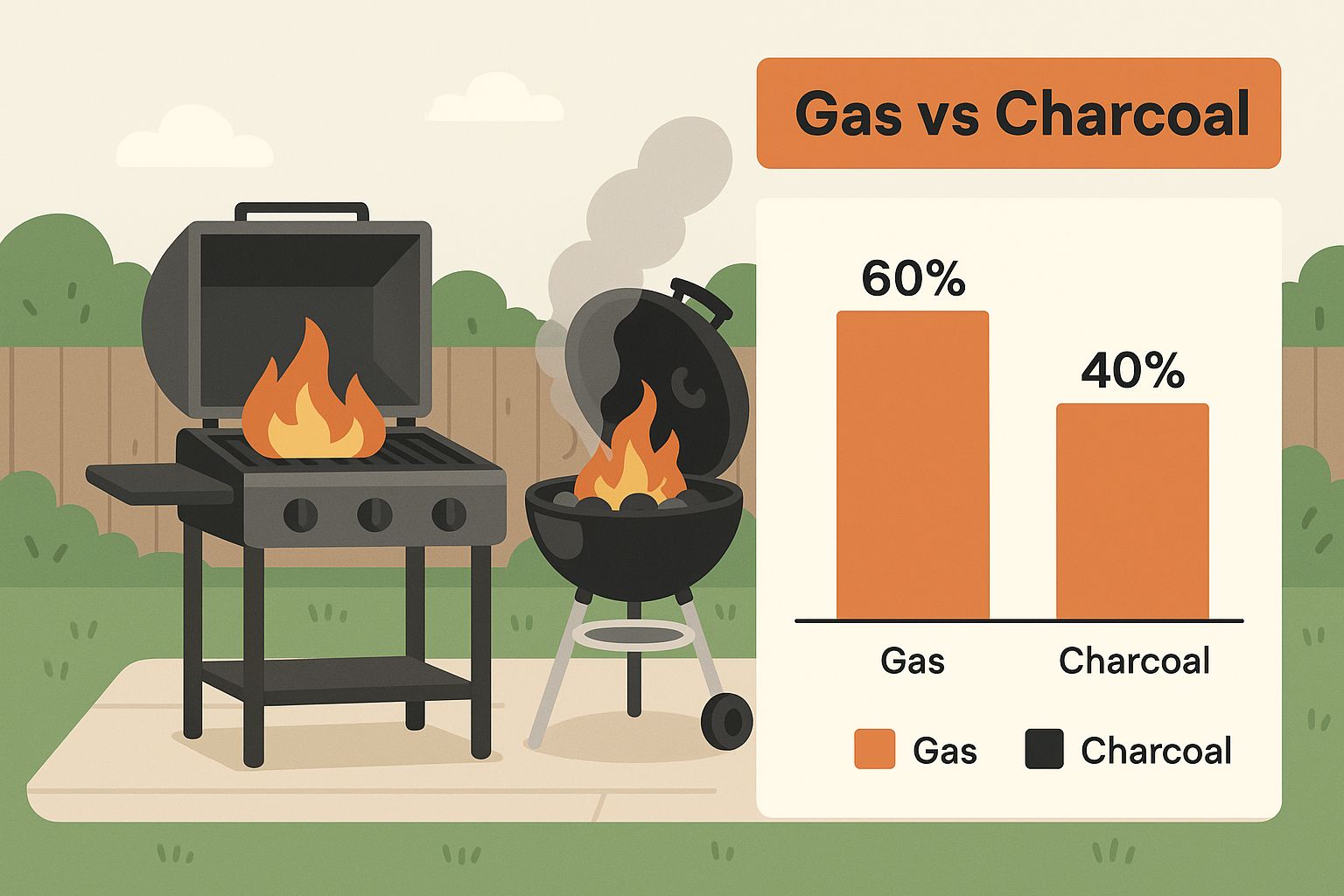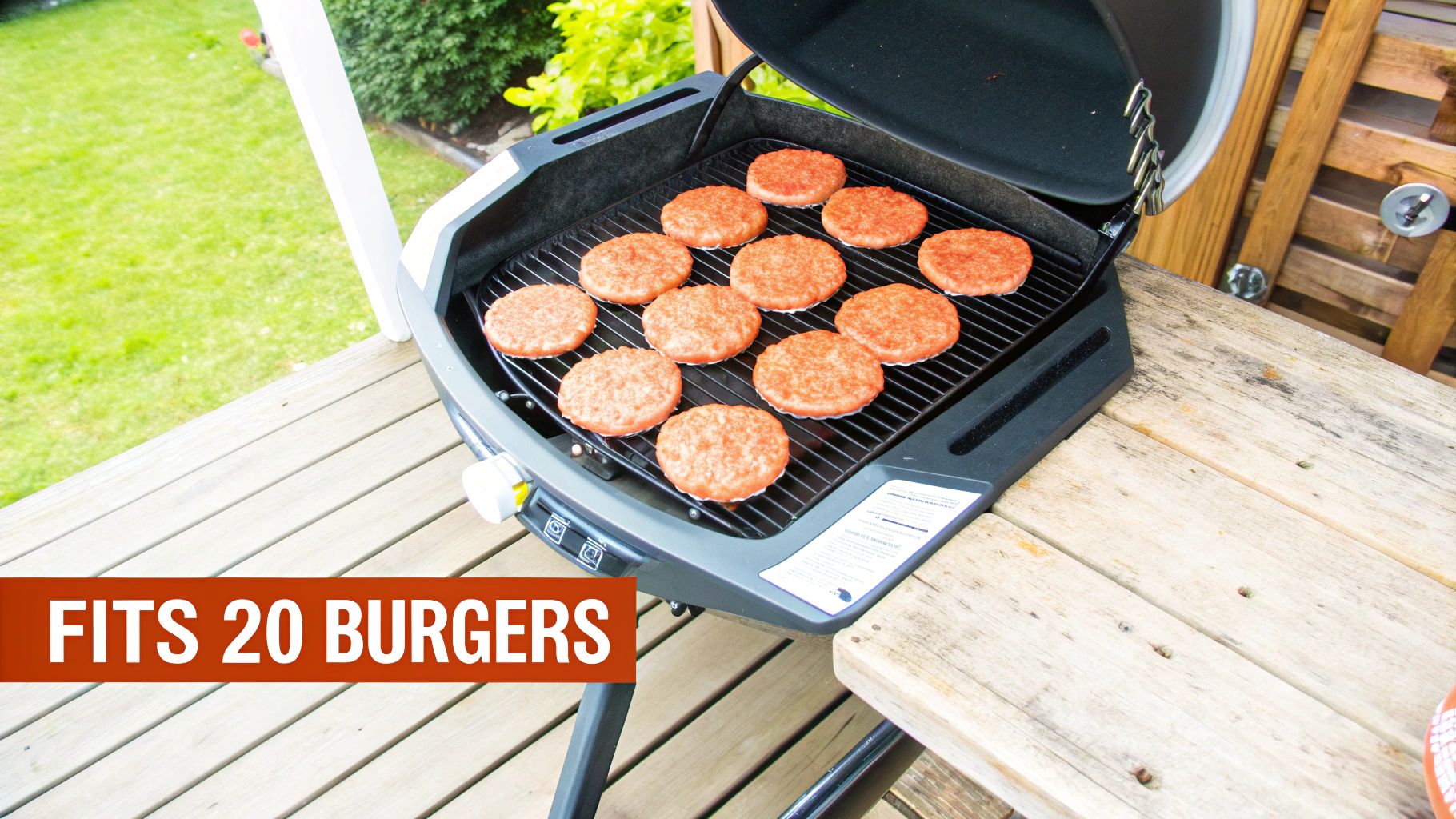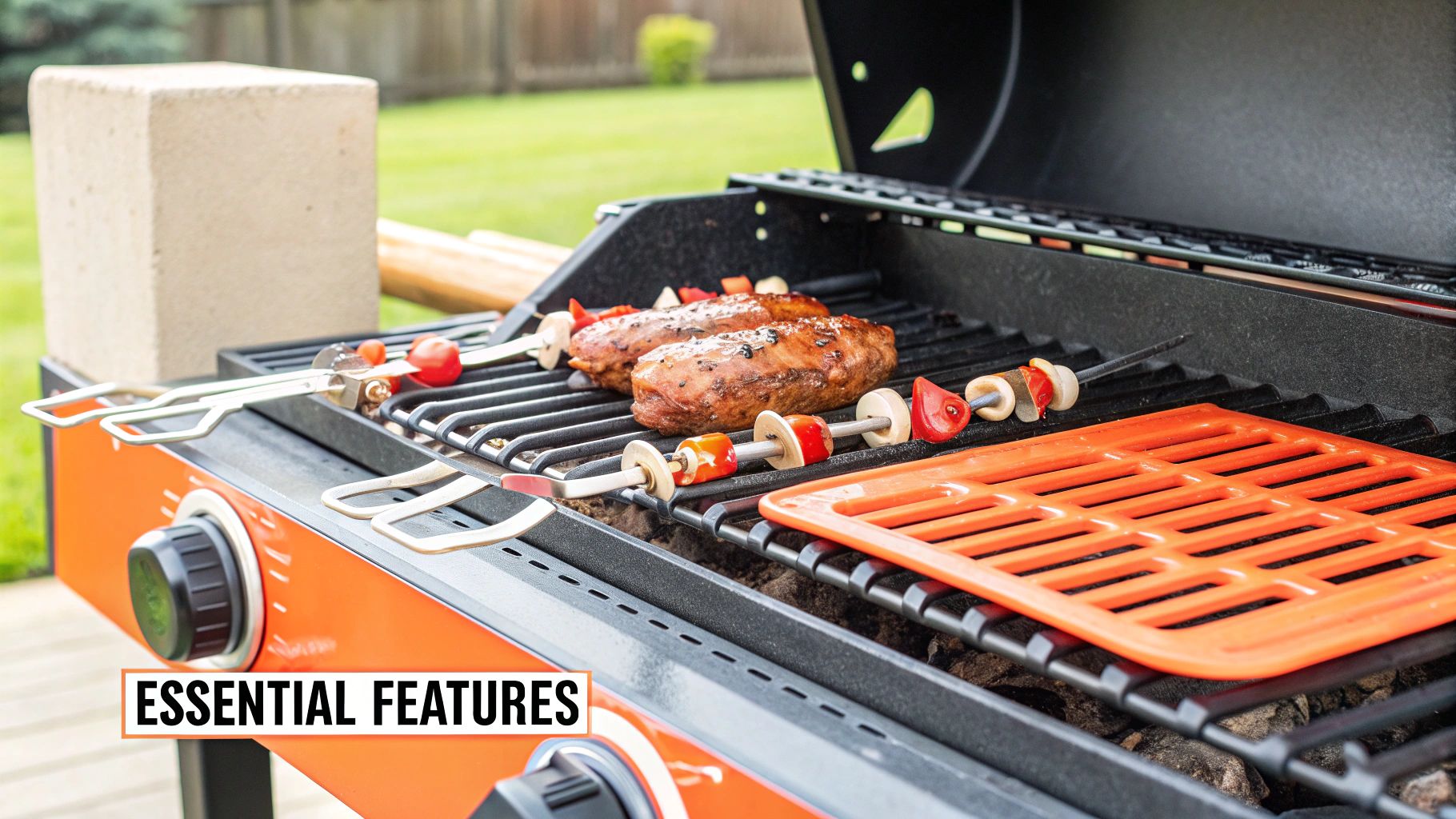-
CALL US:
- (866) 952-3456
When it's time to choose a grill, the first and most important question you need to ask yourself is this: what's going to fuel your fire?
Your answer to that single question will shape everything else. It impacts the flavor of your food, how quickly you can get dinner on the table on a Tuesday night, and the overall experience of cooking outdoors. Deciding between gas, charcoal, pellet, and electric isn't just about the hardware—it's about finding the right fit for your lifestyle.
This is the first major fork in the road. Your fuel source defines your entire grilling experience, from convenience and flavor to how hands-on you want to get. Each type has its own personality, and there’s no single "best" choice—only what's best for you.
For a lot of people, gas grills are all about one thing: convenience. With a gas grill, you can be up and cooking in just 10 to 15 minutes. A simple turn of a knob gives you precise control over the temperature.
It’s this ease of use that makes them perfect for those spontaneous weeknight meals. If you want to fire up some burgers after a long day at work without a big production, a gas grill is your best friend. This is why gas grills dominate the market, holding nearly half of the global market share. Whether you’re using a portable propane tank or a direct natural gas line, their quick ignition and low-maintenance style are hard to beat.
On the other side, you have the charcoal purists. What a charcoal grill lacks in push-button simplicity, it more than delivers in authentic, smoky flavor. For many, cooking over charcoal is a hands-on, rewarding ritual that’s a huge part of the appeal. It turns a simple meal into an event.
There’s just no substitute for the high, dry heat you get from charcoal briquettes or lump charcoal—it’s what creates that perfect, crusty sear on a good steak. Sure, it takes longer to get going (think 20-30 minutes to get the coals glowing), but the payoff is that rich, wood-fired taste that gas just can't touch. Managing the fire creates a primal connection to the cooking process, a lot like tending a backyard fire pit. If you love that feeling, you might also like our guide on how to build a fire pit.
Pro Tip: Not all charcoal is created equal. Lump charcoal burns hotter and cleaner, making it fantastic for searing. Briquettes, on the other hand, provide a more consistent, longer-lasting heat, which is perfect for slower cooking and smoking.
This infographic does a great job of breaking down the key differences.

It really boils down to a trade-off: the instant gratification of gas versus the patient art and incredible flavor of charcoal.
Beyond the big two, a couple of other options have carved out their own space in the grilling world. Here’s a quick look at the main fuel types to help you see how they stack up.
This table breaks down the four main players head-to-head, giving you a quick comparison of what matters most when you're deciding.
| Fuel Type | Best For | Flavor Profile | Ease of Use | Avg. Heat-Up Time |
|---|---|---|---|---|
| Gas | Convenience & Control | Clean, neutral flavor | Very Easy | 10-15 minutes |
| Charcoal | Authentic Smoky Flavor | Rich, smoky, wood-fired | Moderate (requires practice) | 20-30 minutes |
| Pellet | "Set-it-and-forget-it" Smoking | Subtle, consistent wood flavor | Easy | 15-20 minutes |
| Electric | Apartments & Small Patios | Minimal "grilled" flavor | Very Easy | 10-15 minutes |
As you can see, there’s a grill for every situation.
Pellet Grills: These are the ultimate hybrid, offering the wood-fired flavor of charcoal with the automated convenience of a gas grill. An auger feeds hardwood pellets into a fire pot, letting you dial in an exact temperature for everything from smoking a brisket to baking a pizza.
Electric Grills: If you live in an apartment or condo with restrictions on open flames, an electric grill is your answer. They're compact, incredibly safe, and a breeze to clean. You won't get that classic smoky profile, but they offer a reliable way to grill on a balcony or small patio without any fuss.
Let’s be honest for a minute. Choosing the right size grill is all about being realistic with yourself. It’s so easy to get wowed by those massive, multi-burner behemoths on the showroom floor, but if you’re usually just grilling for your family of four, all that extra space is just going to go to waste. A grill that’s too big wastes fuel, takes forever to heat up, and eats up precious patio real estate.

On the flip side, a grill that’s too small can turn a fun get-together into a frustrating, slow-motion cooking marathon where your guests have to eat in shifts. Nobody wants that. The goal is to find that perfect fit for your real-world habits, not just for that one huge blowout bash you throw once a year.
When you're shopping around, you'll see grill manufacturers talk about the cooking area in terms of primary square inches. This is just the main grate surface—the place where the real magic happens. Let’s make that number a little more tangible.
Don't Forget the Warming Rack: A secondary warming rack is an absolute game-changer. It’s the perfect spot for toasting buns, keeping finished foods warm, or slowly cooking delicate items like veggies away from the intense direct flame.
The grill's physical size—its total footprint—is just as important as the cooking surface itself. For safety alone, a grill needs plenty of clearance on all sides to prevent heat damage to your home’s siding or deck railings. You also need enough room to actually move around it comfortably while you're cooking.
Before you even think about buying, grab a tape measure and check your intended spot. Think about your workflow, too. Where will you put platters of uncooked food? Where will your tools go? Getting the dimensions right is crucial, and the same principles apply when you learn how to measure furniture for an indoor space. Taking this simple step ensures your new grill not only cooks like a dream but also fits safely and practically into your outdoor living area.
Modern grills are often loaded with an impressive, and sometimes overwhelming, array of features. We're talking glowing knobs, Wi-Fi connectivity, and all sorts of built-in smart tech. While some of these can genuinely improve your cooking game, others are little more than expensive gimmicks.
The key is to figure out which features add real value and which ones just jack up the price tag. Before you get dazzled by the shiny extras, you need to focus on the fundamentals.

It all starts with the cooking grates—the surface where the magic happens. The material here makes a huge difference in both performance and cleanup.
Another absolute non-negotiable is a reliable ignition system. Trust me, a faulty igniter is one of the most common—and frustrating—points of failure on a grill. You'll want to look for models with electronic ignition systems that are well-protected from grease and weather. It ensures a consistent, safe start every time you're ready to cook.
Once you've nailed down the core components, you can start thinking about the extras. These are the features that can take your grilling experience from good to great, but only if they actually fit how you cook.
A side burner is a perfect example. For some people, it’s an indispensable tool for simmering a pot of BBQ sauce, sautéing onions, or boiling corn on the cob without running back and forth to the kitchen. If you love cooking entire meals outdoors, a side burner is a game-changer. But if you pretty much only grill burgers and dogs, it’s an expensive feature you’ll probably never touch.
In the same vein, a rotisserie kit can be a fantastic addition if you dream of perfectly roasted, self-basting chickens or roasts. The slow, steady rotation produces incredibly juicy and evenly cooked meat. If that makes your mouth water, it's worth the investment.
The latest trend to hit the grilling world is the integration of smart technology. We're seeing more and more grills with Wi-Fi connectivity, app-controlled temperature adjustments, and integrated meat probes. These tools can be incredibly helpful for long, low-and-slow cooks, letting you monitor a brisket from the comfort of your couch.
For the tech-savvy pitmaster, integrated probes and Wi-Fi can take all the guesswork out of hitting that perfect internal temperature. But for the casual griller, they can add a layer of complexity—and cost—that just isn't necessary for grilling steaks and chicken wings.
At the end of the day, the best features are the ones you will use consistently. Be honest with yourself about your cooking style. A simple, well-built grill with high-quality grates will always outperform a flimsy, feature-packed model. Choose the tools that will help you make the food you actually love to cook.
A great grill isn't just a one-off purchase; it's an investment in countless backyard cookouts and family dinners. When you start shopping, you’ll see everything from simple models under $300 to pro-level setups that can easily run into the thousands. The real trick is understanding what you’re actually getting for your money at each price point.
It’s about more than just the sticker price—it’s about long-term value. Sure, a cheaper grill might get you through a season or two, but if you have to replace it every other year, those costs add up fast. Sometimes, spending a bit more upfront saves you a lot of money and headaches down the road.
As you move up in price, you're mostly paying for two things: better materials and tougher construction. This isn't just for show; it directly impacts how well your grill holds heat, stands up to bad weather, and performs year after year.
For example, a lot of entry-level grills are made with 430-grade stainless steel. It looks shiny and nice in the store, but it’s much more likely to rust. Jump up to a mid-range or premium grill, and you'll probably find 304-grade stainless steel, which is a beast when it comes to resisting corrosion and will look good for years.
Pro Tip: Give any grill you're considering a good shake. A wobbly cart, a flimsy lid that doesn't seal tight, or thin, bendy metal are all bad signs. A well-built grill feels heavy and solid—that sturdiness translates directly to better heat retention and a much longer lifespan.
Besides the type of steel, here are a few other upgrades to look for:
The initial price is really just the start. You also have to think about fuel efficiency, potential repairs, and, most importantly, how long the grill is going to last. In today's economy, being smart about these things matters more than ever.
With the cost of everything from beef to buns on the rise, choosing a grill that’s both efficient and built to last is a savvy move. According to some reports, the average cost of hosting a barbecue is projected to climb, thanks to supply chain hiccups affecting major markets in the U.S. and Europe. You can dig into more of the data on consumer trends and grill market dynamics in this detailed worldwide appliance overview from Statista.com.
A long and comprehensive warranty is usually a great indicator that the manufacturer believes in their product. It gives you peace of mind and protects your investment. By focusing on solid build quality from the start, you’ll land a grill that will be the hero of your backyard for many summers to come.
Getting the grill home is a huge win, but let's be real—the job isn't done yet. Your new pride and joy is sitting in a massive, heavy box, a jigsaw puzzle of parts, instructions, and a bag of mysterious hardware. This brings you to your very first post-purchase crossroad: do you build it yourself or call in a pro?
The DIY route can be incredibly satisfying. But it often eats up a few hours, requires the right tools, and demands a healthy dose of patience. A simple mistake during the build can lead to a wobbly grill or, worse, a genuine safety hazard. For many people, the peace of mind that comes with hiring a professional is worth every penny.
If you want it done right the first time, exploring options for expert grill assembly services means you can get right to the good part—cooking—without any of the stress.
Once it’s built, a little routine care will go a long way in extending its life and making sure it performs at its best. A neglected grill quickly falls victim to rust, develops frustrating hot spots, and can have dangerous flare-ups from all that grease buildup.
A few simple habits make all the difference:
A well-maintained grill isn't just about longevity—it's about flavor. A clean cooking surface ensures you taste your food, not the burnt remnants of last week's barbecue.
Finally, it’s easy to get lost in the sea of grill accessories. My advice? Skip the clutter of single-use gadgets and stick to the essentials that actually make a difference. When you're budgeting, don't forget to factor in the cost and utility of essential BBQ accessories.
These three tools are absolutely non-negotiable for any griller:
Alright, you've narrowed it down, but a few nagging questions might be holding you back. It happens. Getting those final details sorted is what turns a good choice into a great one. Let's clear up some of the most common things people ask right before they pull the trigger.
It's easy to get fixated on a big BTU number—it just sounds powerful. But here's the reality: BTUs (British Thermal Units) only measure the gas burners' heat output, not how well the grill actually cooks. A well-built grill with a heavy, tight-fitting lid will hold heat far better than a flimsy one, meaning it can do more with fewer BTUs.
Think of it this way: a well-insulated oven doesn't need a massive burner to maintain its temperature. The same logic applies here. Instead of just chasing the highest number, look for quality construction. A good rule of thumb is 80-100 BTUs per square inch of the main cooking area, but let solid materials and a sturdy build be your real guide.
In most cases, yes. But what you're paying for isn't just a brand name; it's longevity and performance. The price tag on a grill is usually a direct reflection of the materials, the build quality, and the warranty that backs it all up. Premium grills often use higher-grade stainless steel that resists rust, feature heavier grates that eliminate hot spots, and are backed by impressive 10-year or even lifetime warranties.
Sure, a budget-friendly grill can cook a perfectly good burger. But you might find yourself replacing it in just a couple of seasons. When you invest in a higher-end grill, you're paying for a piece of equipment that will perform consistently for years and years of backyard cookouts.
A pricier grill is an investment in durability. You're paying for superior materials that resist rust, retain heat better, and withstand the elements for years, not just a single summer.
Getting these two techniques down is what separates the novices from the grill masters. They're two completely different ways of cooking, and knowing when to use each will open up a whole new world of possibilities.
Direct Grilling: This is what most people think of when they imagine grilling. You cook the food right over the flames or hot coals. It’s a high-heat method that's perfect for getting that beautiful sear on things that cook fast, like steaks, burgers, and hot dogs.
Indirect Grilling: This is how you turn your grill into an outdoor convection oven. You set up your heat source on one side and place your food on the other, away from the direct flames. This allows it to cook with gentle, circulating heat—ideal for bigger items like a whole chicken, a rack of ribs, or a pork shoulder that need to cook "low and slow" without getting torched on the outside.
Mastering these methods really expands what you can do. It's all about controlling the heat, which is a key safety principle for any backyard appliance. On that note, our guide on fire pit safety tips shares some great advice on responsible heat management that applies here, too.
Ready to get grilling without the headache of assembly? Let the experts at Assembly Smart build your new grill perfectly so you can start cooking today. Book your professional grill assembly now!